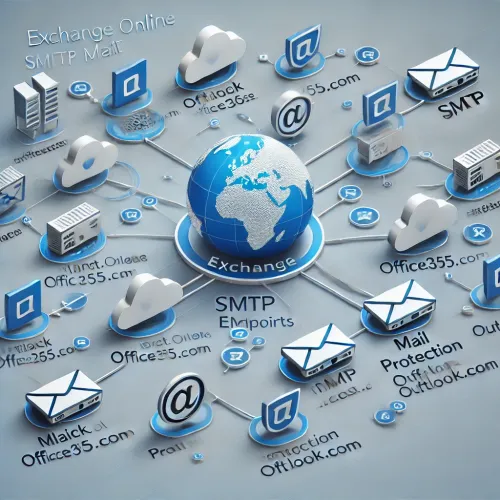
Knowledge base
September 10, 2024
Exchange Online SMTP mail endpoints: Everything you need to know
Exchange Online is one of the most widely used solutions for business e-mail services.
But did you know that there are different SMTP mail endpoints for incoming mail?
These endpoints play a crucial role in how emails are delivered in your Exchange Online environment.
In this article, I’ll explain what these endpoints are, how they work, and what to look out for when configuring your Exchange Online environment.
What are SMTP mail endpoints? ????
SMTP (Simple Mail Transfer Protocol) is the protocol used for sending e-mails over the Internet.
Within Exchange Online, several endpoints are used to process incoming e-mails.
These endpoints ensure that e-mails are properly delivered to the correct mailboxes.
Key features:
- SMTP mail endpoints act as intermediate stations for incoming mail.
- They ensure that emails are delivered through the proper path and securely.
- Different endpoints can be used depending on the region or type of Exchange Online service.
Why are different endpoints important? ????
Microsoft has distributed Exchange Online to different data centers around the world.
To ensure that e-mail traffic runs efficiently and the servers are not overloaded, Microsoft uses different SMTP e-mail endpoints for different regions.
Benefits of using regional endpoints:
- Low latency: By using an endpoint closer to your region, emails can be processed faster.
- Better reliability: Less chance of outages because traffic is distributed across multiple servers.
- Security: Each endpoint is optimized to handle email traffic securely and quickly.
Overview of SMTP mail endpoints ✉️
Below is an overview of the main SMTP mail endpoints used for Exchange Online:
- outlook.office365.com (Worldwide) ???? This is the most commonly used endpoint for standard Exchange Online users worldwide.
Most organizations will use this endpoint. - smtp.office365.com (SMTP Authenticated Submission) ???? This endpoint is used specifically for SMTP authenticated connections.
Consider scenarios where, for example, you have remote devices that need to send mail through your Exchange environment. - mail.protection.outlook.com (EOP – Exchange Online Protection) ????️ This endpoint is used for incoming mail filtered by Exchange Online Protection (EOP).
This ensures that spam and malware are blocked before they reach your inbox. - *.mx.microsoft (Inbound DANE SMTP Endpoint) ???? This new endpoint is used when you activateInbound DANE.
It provides support for DNSSEC, a critical security measure, and will eventually replace the mail.protection.outlook.com endpoint. - Regional variations ???? Microsoft also offers endpoints for specific regions, such as the United States, Europe, and Asia, to ensure faster processing of emails in your region.
How do you configure the right endpoint? ????️
Choosing and configuring the right SMTP mail endpoint depends on a number of factors.
Here are some important tips:
- Know which region supports your organization: Choose an endpoint that matches your location for optimal performance.
- Check your security settings: Make sure your endpoint meets your organization’s security standards.
- Use EOP for extra security: If you use Exchange Online Protection, make sure this endpoint is set up correctly to filter incoming mail.
Common mistakes when configuring SMTP mail endpoints ????
Sometimes things go wrong when setting up SMTP mail endpoints.
Here are some common mistakes to avoid:
- Wrong endpoint choice: Don’t use just any endpoint; always choose the endpoint that best suits your region and usage scenario.
- Not setting up authentication: Especially with smtp.office365.com, it is essential to configure proper authentication to ensure that only authorized users can send emails.
- Endpoints not keeping up-to-date: Microsoft regularly updates its infrastructure.
Make sure you always use the latest endpoint information to avoid problems.
Conclusion ????
Configuring the right SMTP mail endpoints for Exchange Online is essential to ensuring that your email traffic runs smoothly and securely.
By understanding which endpoints are in place and how to set them up correctly, you can ensure that your organization takes full advantage of the benefits of Exchange Online.
Do you have questions about settings or want to know more about how to optimize Exchange Online for your organization?
Feel free to contact me!
????
Want to know more?

Related blogs
Tech Updates: Microsoft 365, Azure, Cybersecurity & AI – Wekelijks in je Mailbox.



